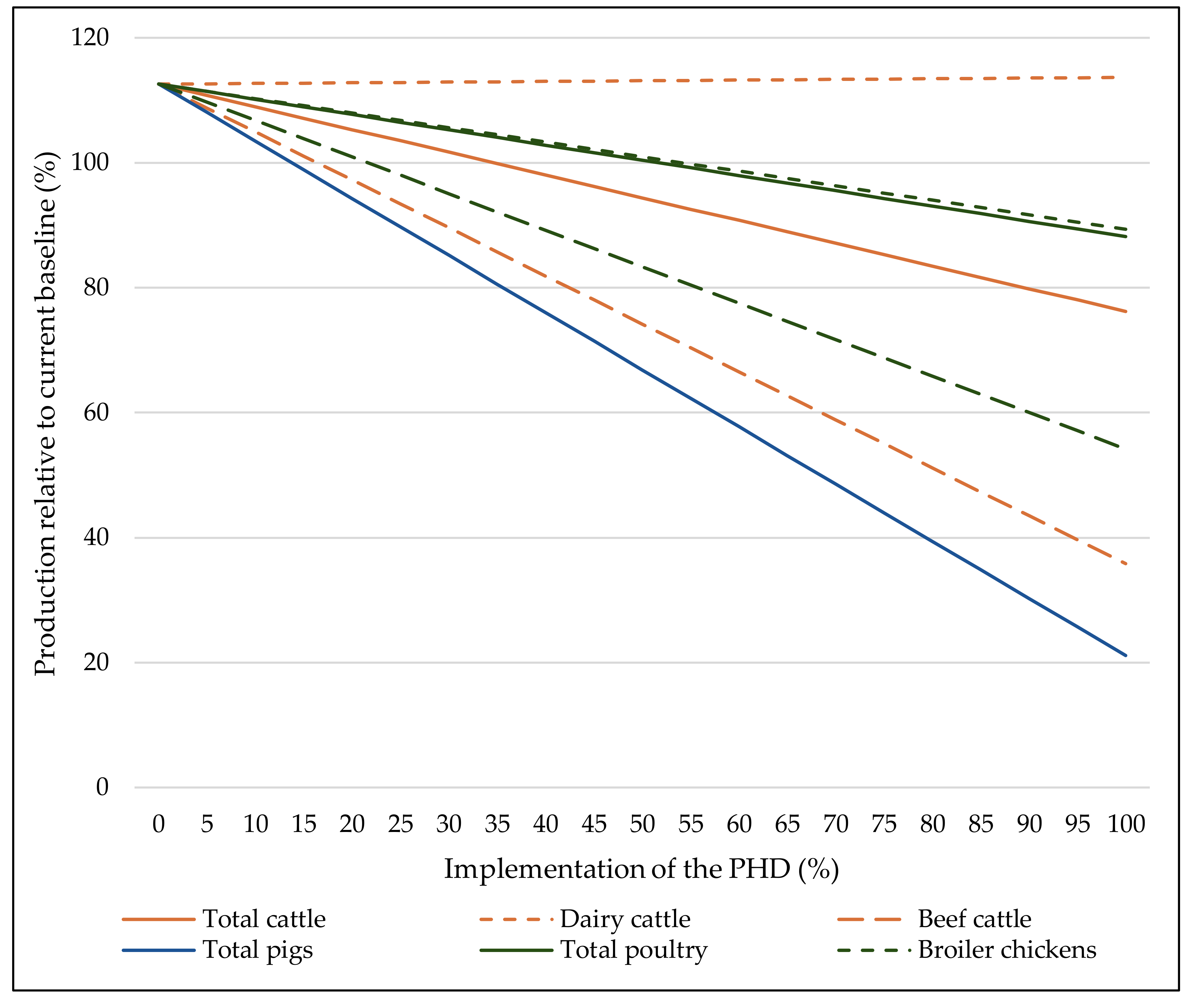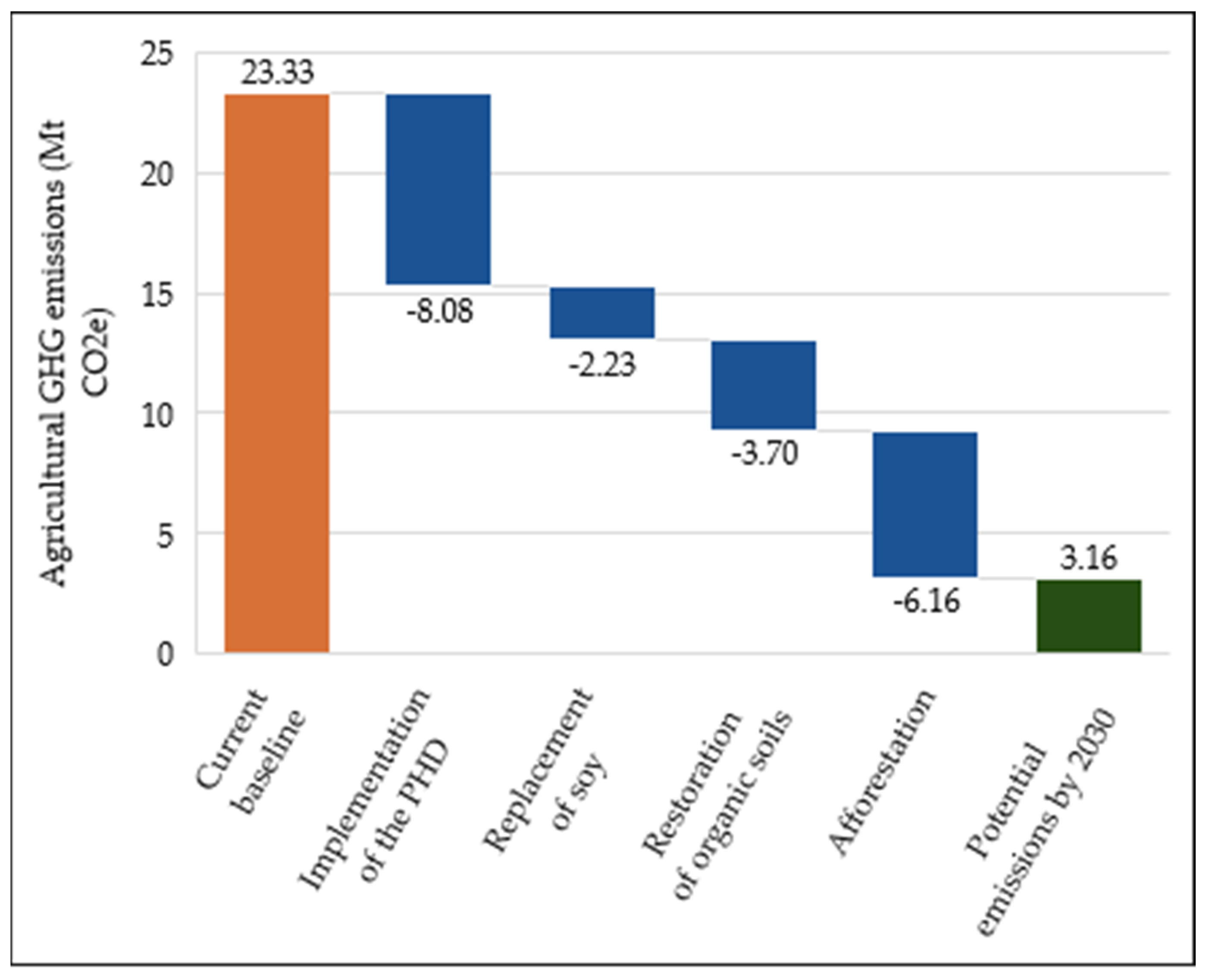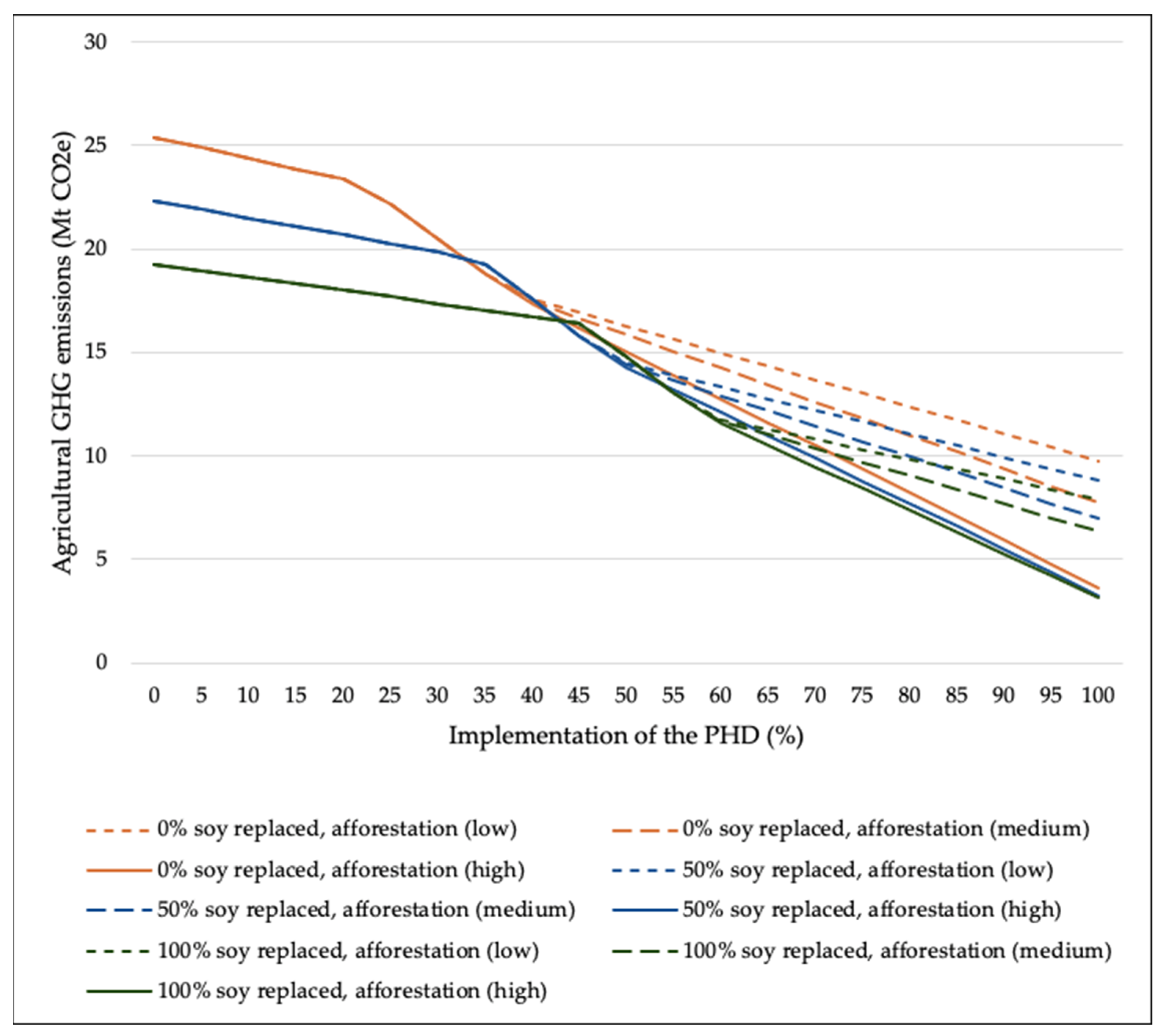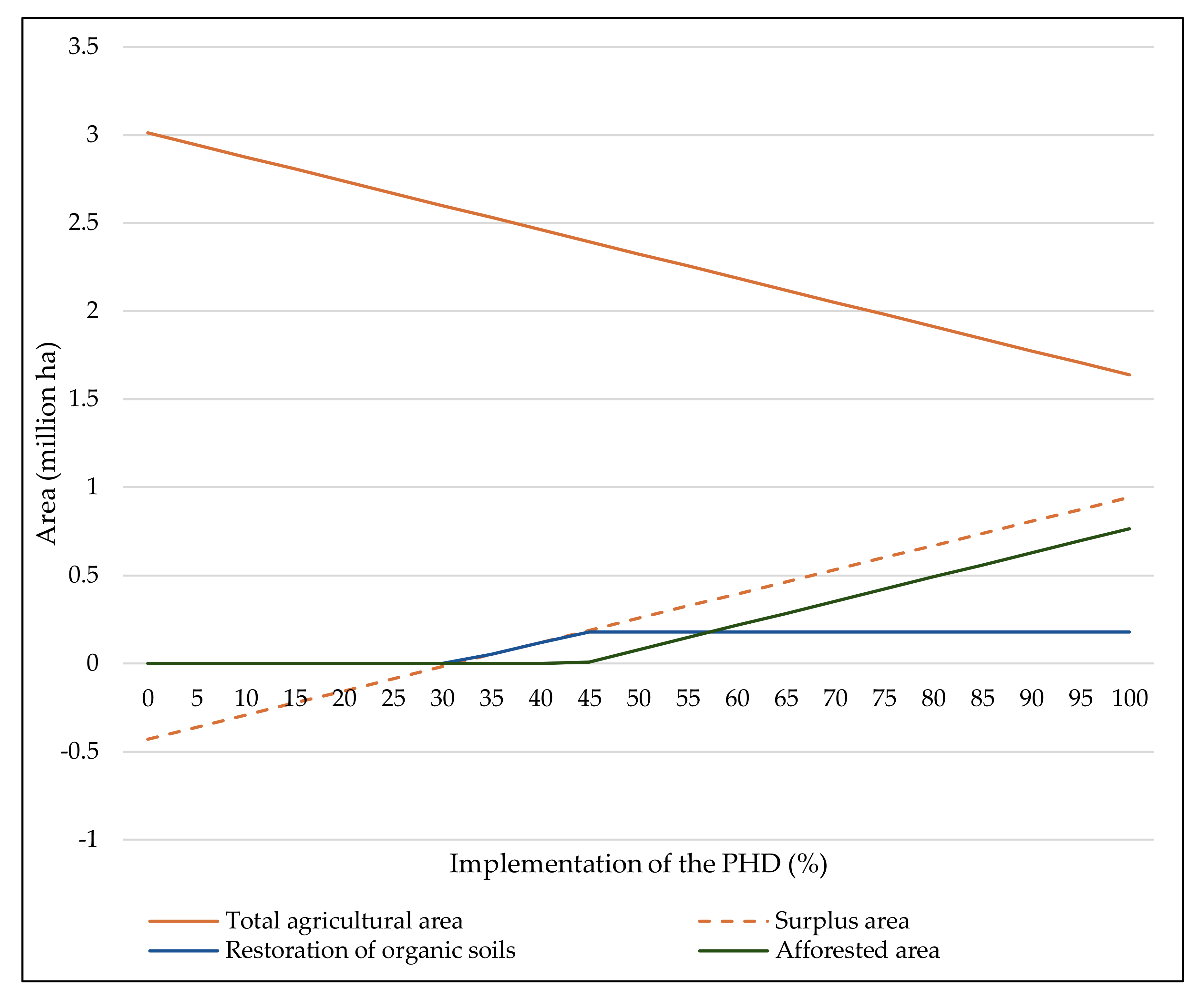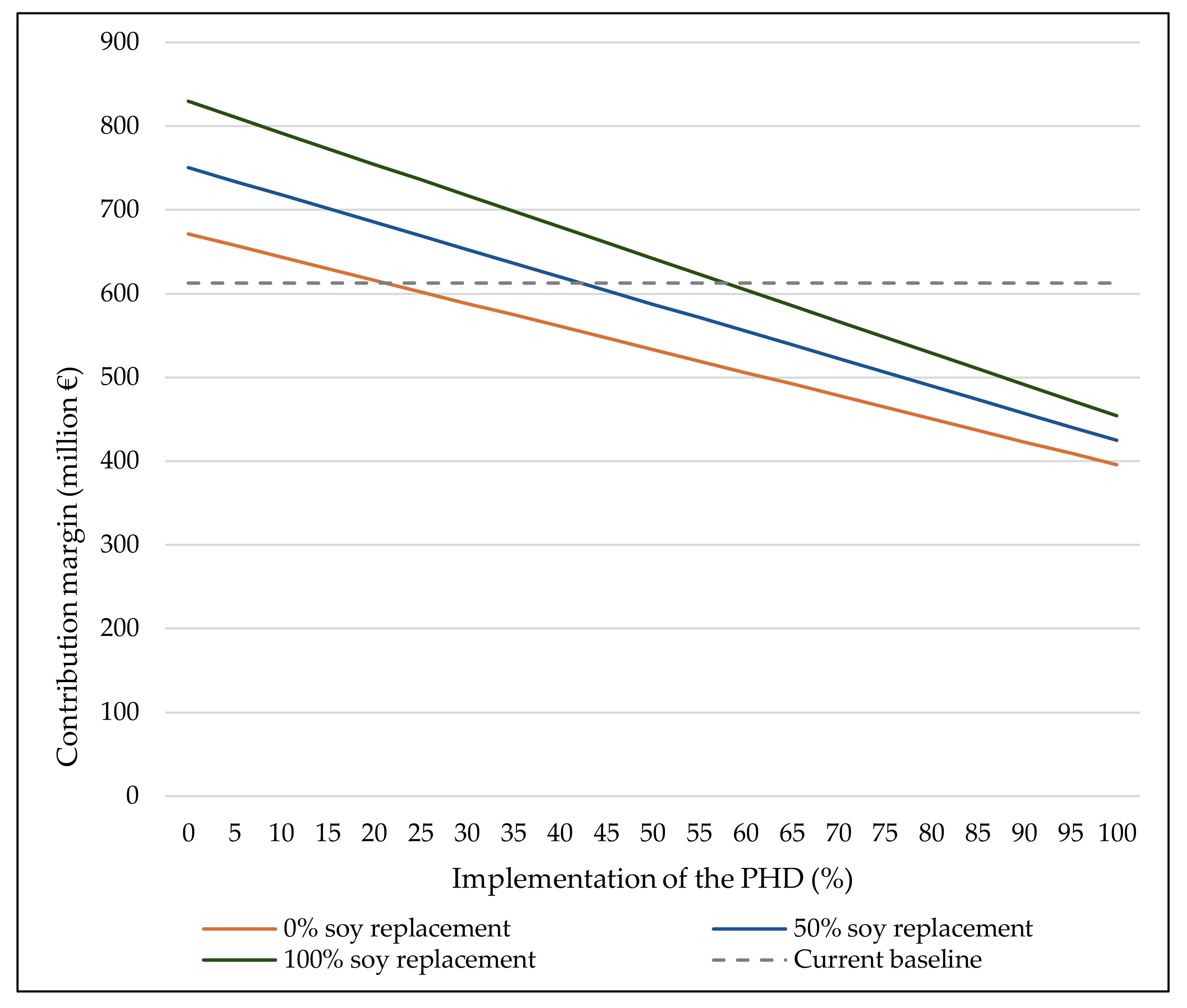1. Introduction
Tackling the climate impact of agriculture is receiving increased attention, because achieving the goals of the Paris Agreement will not be possible without a substantial transformation of the global food system and the agricultural sector [
1,
2,
3]. Currently, 21–37% of global greenhouse gas (GHG) emissions can be attributed to the food system [
4]. Previous estimates have found that livestock alone accounts for about 14.5% of global GHG emissions when including emissions from ruminants, feed production, and land use change [
5]. Numerous studies have argued for the need to reduce meat consumption and livestock production [
2,
6,
7,
8]. The European Green Deal, focusing on making the EU climate neutral by 2050 [
9], features a Farm to Fork Strategy aimed at accelerating the transition to a sustainable food system and mitigating climate change [
10]. In the communication and action plan for this strategy, a transition towards healthy, sustainable, and more plant-based diets is emphasized. Such a shift will require downscaling of livestock production, and there is a need for research to identify opportunities and barriers for the conversion of animal feed production to plant-based food production. In Denmark, the agricultural sector is responsible for about 23% of national emissions, with production of cattle and pigs being the dominant source [
11]. The Danish government has pledged to reduce national emissions by 70% in 2030 relative to 1990 levels [
12], corresponding to a reduction from the current 51.3 Mt CO
2e (2018) [
11] to 21.8 Mt CO
2e. In a recent report the Danish Climate Partnership for the Food and Agriculture Sector suggests that a reduction of 5.1 Mt CO
2e by 2030 is possible through already known measures, with an additional 2.5 Mt CO
2e from forestry, food processing, and food waste, and 2.2 Mt CO
2e through research and development of new technologies. These potential reductions come at an estimated cost of €3.43 billion [
13]. Measures to facilitate a shift towards more plant-based food production are not included, but different options for promoting plant-based food are mentioned. The agricultural sector has expressed readiness to meet an increasing demand for more plant-based food [
14,
15], already evident in both Denmark and Europe [
16,
17,
18,
19]. Additionally, the National Danish Council on Climate Change advising the Danish Government considers a transition towards a more plant-based food production system vital for achieving the national climate target and achieving a sustainable Danish food system [
20,
21]. A starting point for such a transition could potentially be the Planetary Health Diet (PHD) suggested by the EAT-Lancet Commission [
1]. The PHD is primarily plant-based and features dietary recommendations that contribute to keeping global warming below 2 °C and promote human health. It thereby exploits the significant health and climate co-benefits of plant-based food on human health and climate change mitigation documented in several studies [
1,
22,
23]. Taking departure from the current baseline agricultural GHG emissions, the aim of this study is to analyze the potential for reducing the climate impact of Danish agriculture. The study develops transition scenarios for a sustainable conversion from animal-based to plant-based food production, associated with a projected increasing global implementation of the PHD. Based on this analysis it can be concluded that there is significant potential for reducing the GHG emissions from agriculture by transitioning from being primarily based on livestock and animal feed production, towards focusing on providing more plant-based food for human consumption. In the case of Denmark, emission reductions in the range of 13.6–20.2 Mt CO
2e (58.2–86.5%) will be possible with full global implementation of the PHD in a scenario where domestic cattle, pig, and chicken production is downscaled to 76.2%, 21.1%, and 88.2% of current production.
4. Discussion
This study has shown that a 100% implementation of the PHD results in emissions reductions of 13.6–20.2 Mt CO
2e for Danish agriculture, corresponding to 58.2–86.5%, depending on the assumptions made for replacement of imported soy, restoration of drained organic soils, and afforestation. Reductions on par with those currently pursued by the sector (9.8 Mt CO
2e) are achievable through a 55% implementation of the PHD, assuming a 50% reduction in soy imports and a medium effect of afforestation. A PHD implementation level of 40% by 2030 has previously been presented as a realistic target [
59]. In the present study this would result in reductions of 5.8–6.6 Mt CO
2e depending on assumptions, which corresponds to 24.7–28.2% relative to the current baseline. Thus, it is evident that there is much to gain from being more ambitious. The importance of utilization of the surplus agricultural area is also apparent, especially at high implementation levels where more land is available. Afforestation of the total surplus area with fast growing spruce (high estimate for effect of afforestation) is perhaps not the most realistic outcome. Using a medium estimate for the effect of afforestation, baseline emissions can be halved through 65–70% implementation of the PHD and 50% reduction in import of soy. If no soy is assumed to be replaced and a low estimate for afforestation is used, baseline emissions are halved at 85% implementation of the PHD. Due to the specific factors included in this study with regard to land use change and soy imports, as well as the specific focus on Denmark as a case study, it is difficult to compare results directly to other studies. However, previous studies have found similar reductions in GHG emissions on a global scale from the implementation of various diets, including reduced meat consumption and lower livestock production. Findings from these studies include a reduction in emissions of 56% from shifting to a flexitarian diet [
2], 49% from shifting to a vegetarian diet [
7], and 29–70% from several different diet scenarios that include a reduced intake of meat [
22]. One LCA study done in a Danish context found reductions of 14–44% from shifting to vegetarian and vegan diets [
21]. These studies add to the results showing significant potential for lowering emissions through a reduction in meat production.
A transformation of the entire food production system of a country with a strong agricultural sector like Denmark could be viewed as a pipe dream, an unattainable and unrealistic goal for a country whose agricultural production is based on public demand for large amounts of animal products. However, there is no arguing with the fact that a change is necessary [
1,
2,
3]. Consumers are already displaying an increasing interest in and demand for plant-based food commodities [
17,
18,
19,
59], and recently it has been suggested that research focusing on the transition to an increasingly plant-based agricultural sector should be prioritized over further research into improvements in animal agriculture [
60]. Furthermore, the agricultural sector itself has expressed interest in moving towards more focus on plant-based foods to meet an increasing demand from consumers [
14,
15]. It can also be argued that a transition from animal-based to plant-based food production is actually not more complicated or inaccessible than the approaches currently planned by the sector. Reduction of 9.8 Mt CO
2e across the entire agriculture and food sector is the current goal, to be achieved through various adjustments to practices and technologies [
13]. These include an expected reduction of 2.2 Mt CO
2e from future technologies, featuring a method for producing jet fuel and biochar from agricultural by-products, biorefinery of grass, biofilters, and methane-reducing feed additives for cattle. Aspects of the sector’s current recommendations for climate mitigation measures carry the risk of technological and financial lock-ins, resulting in less sustainable overall development. This phenomenon has previously been described for various agricultural development pathways, e.g., agricultural policies that hinder crop diversification and technologies that necessitate pesticide use by smallholder farmers [
61,
62,
63,
64]. In particular, the current recommendation for large investments in biorefinery of perennial grass to replace soy as feed for pigs coupled with investments in biogas plants requiring degassed pig slurry, should be critically reviewed. It may become a barrier for a more sustainable long-term solution featuring a transition to more plant-based food production for human consumption. The transition scenarios presented here require large-scale transformations at every level, from policymaking down to the individual farmer. However, at its core the transition is quite simple: reduce the animal population and replace some of the production of animal feed with production of food crops for human consumption. Additionally, it is possible to combine the measures in the present scenarios with some of the technological measures already planned by the sector, e.g., use of methane-reducing feed additives and nitrification inhibitors in fertilizer or changed slurry handling practices and technology [
13]. Combining these measures would reduce emissions further and could potentially lead to net zero emissions, or even net negative emissions.
Implementation of the transition scenarios will of course result in costs for both the sector and the wider society. However, the estimates in this study suggest that they will be low compared to the costs of other suggested approaches. At 100% implementation of the PHD, the deficit relative to the sector’s current contribution margin is between €158.5 and €217.0 million, depending on assumptions for soy replacement. This does not include expenses related directly to the transition, such as replacement of machinery, but also does not include savings resulting from the replacement of imported soy. Further research into the economic aspects of this type of transition would yield a more precise estimate of the costs and benefits, making it more directly comparable with the economic impact of other mitigation strategies for the agricultural sector. Importantly, the costs of the transition should not rest on the sector alone. For society, there are potential co-benefits from facilitating a transition towards an agricultural sector that can supply the population with more plant-based foods. Besides obvious savings on climate change adaptation that will result from investing in mitigation, a healthier diet can also result in savings on healthcare. The PHD used in this study is a healthier diet than the one currently consumed in Denmark and in Europe in general [
1,
26,
33], and is specifically designed to be optimal for both human and planetary health [
1]. A recent report reviewed the potential economic benefits for the Danish society if the population followed the current dietary guidelines. It was found that if Danes reduced their intake of red and processed meat to 500 g per person per week, society would save €657.1–764.5 million, depending on the method of calculation [
65]. The reduction in meat intake implicit in the PHD can thus in itself contribute significantly to offsetting societal expenses related to an ambitious transformation of the agricultural sector.
Since the publication of the PHD, it has been criticized by actors from the agricultural sector because of the significant and difficult changes implementation of the diet would necessitate in the sector [
66,
67], and has also been targeted by consumers in a social media campaign [
68]. Another criticism has centered around the PHD being economically unattainable for a major part of the global population [
69]. These are valid concerns which deserve to be addressed. Firstly, the PHD is a reference diet estimating the consumption of individual food groups averaged over the total global population, and it is one of the first attempts at quantifying a transition to a more climate-friendly diet. Local interpretations and adaptations of the diet will of course be necessary, to ensure that the diet is feasible and can be integrated into local food systems and cultures. Additionally, while the diet is global in its scope, there is no doubt that for the sake of planetary health, it is mainly diets high in animal products that need to be addressed [
2,
6,
7,
8]. One aspect of the PHD that mainly addresses developed countries’ consumption of animal products is the recommended intake of dairy in the diet. The recommended average intake in the PHD is on par with the current global per capita production [
1,
33], but significantly lower than, e.g., the Danish average consumption [
38]. The EAT-Lancet Commission cites several studies in their report finding that the existing very low consumption of dairy in many cultures does not correlate with negative health effects [
1]. Thus, it is possible to make locally adapted recommendations for, e.g., dairy. Populations with a lower average consumption of dairy than recommended in the PHD can be encouraged to maintain their low level, while populations that consume high amounts of dairy can be encouraged to reduce. This is the case for all the food groups presented in the PHD. In every case there is a recommended range, enabling the diet to be adapted both on a population and individual level. Regardless of how the diet is adapted, it stands to reason that there will be significant changes in the agricultural sector. These will have to be tackled politically to address farmers’ and consumers’ concerns for what this transition would mean for farmers’ livelihoods and consumers’ preferred eating habits. Incentives and support for farmers and workers in the meat industry transitioning to production of other crops and alternative employment would be necessary.
It has been argued that Danish animal production is so climate-friendly that no reduction is needed; for example, in a recent report comparing the climate impact of Danish pork and dairy production with other selected countries. This report found that Denmark’s production of those two commodities is among the most climate-friendly in the world [
70]. However, it is important to note that emissions from animal production remain much higher than from plant production, and that experts agree that a global transition to a more plant-based diet is necessary for sufficiently ambitious climate-change mitigation [
1,
2,
3]. Denmark is a relatively rich country in a relatively rich region, and consumers, both in Denmark and Europe, are currently displaying increasing interest in plant-based foods [
16,
17,
18,
19]. Beginning a transition towards a more plant-based agricultural production could make European farmers and companies important players in the market for plant-based foods, and would also set a good example for inspiring other regions towards beginning the process.
Political action and dedicated support for the agricultural sector are required in order to incentivize changes in both production and consumption. This should include: (i) providing guidelines and establishing pilots for efficient and sustainable conversion of livestock production to plant production in collaboration with the farmer advisory services, (ii) targeting subsidies towards production of plant-based food commodities [
47], coupled with (iii) implementing measures for increasing the capability, opportunity, and motivation of consumers that will make it easier and more acceptable for them to make a primarily plant-based and healthy diet the preferred choice [
71,
72,
73], and iv) considering adopting a carbon tax on food, as suggested by the Danish Council on Climate Change [
20]. New actors in the market, such as producers of plant-based alternatives to meat and dairy, can potentially accelerate this transition because they are not invested in maintaining the status quo as more established actors are [
74].
Most important in facilitating the transition within the European Union are the EU agricultural policies. These need to incentivize a shift towards increased production of plant-based foods to replace some of the animal production. The EU has recently presented its Farm to Fork Strategy as part of the new European Green Deal [
10]. This strategy is committed to promoting more environmentally sustainable and healthy food consumption, specifically a more plant-based diet, and is also supporting more sustainable food production. However, the consumption and production goals in the strategy are not directly linked. None of the suggested measures for achieving a sustainable European food production system include facilitating a shift towards more plant-based food production, even though a downscaling of animal production and increase in plant production would fit well with the goal of reducing consumption of red meat and increasing consumption of plant-based foods. Therefore, it will be important to establish such a link in the proposal for a legislative framework for sustainable food systems announced in the Farm to Fork Strategy Draft Action Plan and due in 2023 [
10]. Additionally, the upcoming revision of the EU Common Agricultural policy for 2021 to 2027 should provide economic incentives for promoting a transition to more plant-based agricultural production. Furthermore, it is necessary that all actors, from policymakers in the EU to national agricultural organizations, researchers, consumers, and individual farmers, work together towards the same goal and remain aware of the importance of making ambitious changes.
